No Results Found
The page you requested could not be found. Try refining your search, or use the navigation above to locate the post.

USA EV sales for July again improved on a year over year basis, show a 17% growth over July 2016 and standing at 35% higher for the year to date despite slumping 9% from June 2017. The drop in sales from June can be attributed to seasonal factors as 2017 and 2016 sales trends has been a carbon copy thus far. Pure electric vehicles are still the better seller, mainly due to Tesla, which contributes around 46% of all BEV sales, but plug-in hybrids are gaining on as more models have been introduced over the comparison period. By July 2016 BEVs were outselling PHEVs by 13% while by July 2017 BEVs only commanded a lead of 7.5%. The top 3 brands are unchanged but Tesla’s lead has shrunk as the Chevrolet Bolt and Volt sales grew. Ford remained at the third position but have seen its sales slipping about 6.5%.
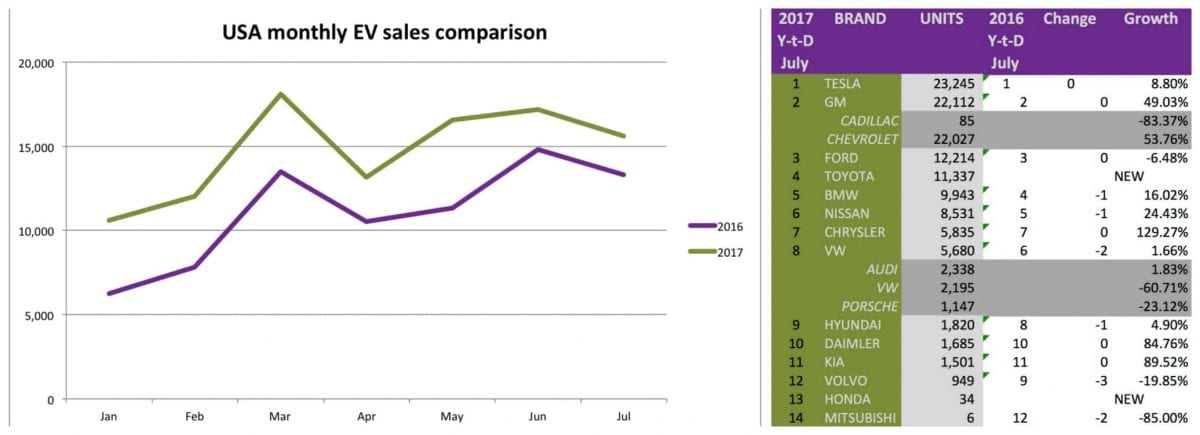
We provide detailed tables below showing the brand, overall sales, and technology categories. We have created new pages on wattev2buy providing infographics ranking EVs range and price in the USA, UK and EU and also ranking EVs by efficiency in the USA. Please peruse share and comment.

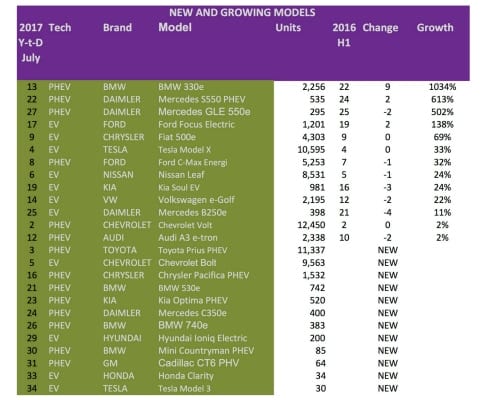
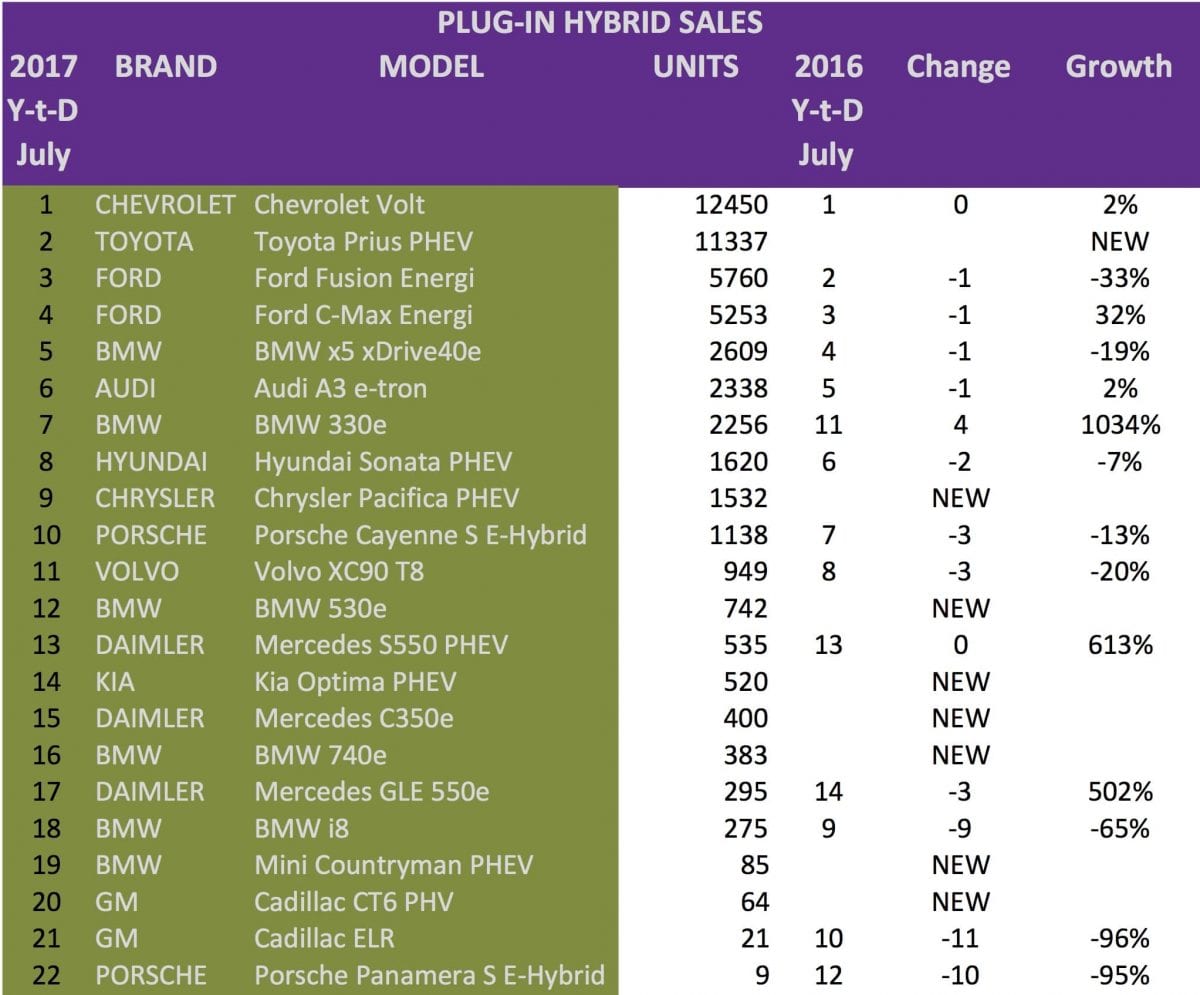
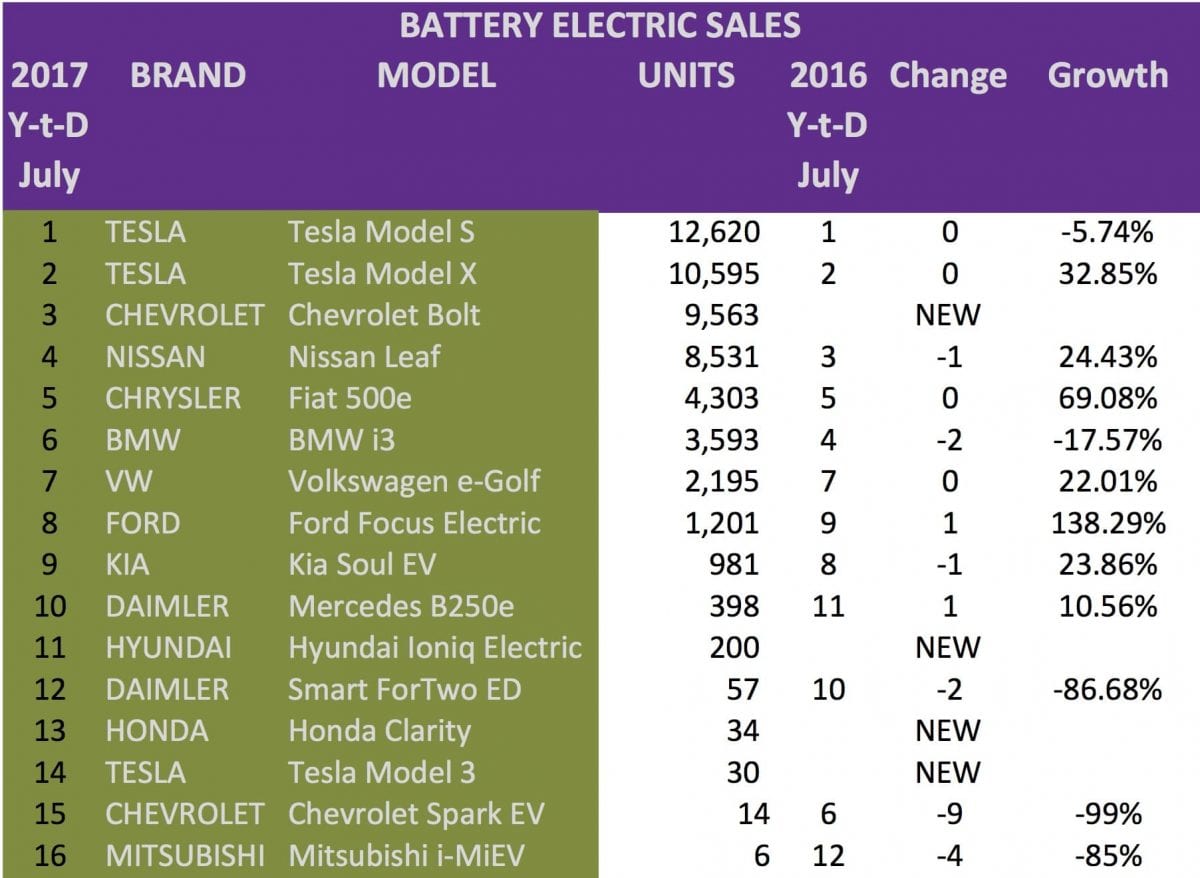
Toyota and Mazda this week announced that they would jointly develop a $1.6bln plant to produce Corolla and Mazda SUV EVs by 2021. The plant will have a capacity of 300,000 units per annum and create 4,000 US jobs. The move is in answer to the following factors:
The JV includes Toyota taking a 5% stake in Mazda, while Mazda will acquire a 0.25% share in Toyota.
Mercedes announced that it would phase out its first generation electric vehicle, the B250 ED which went on sale in 2013. Mercedes will not replace the B250 ED assembled at the Rastatt plant in Germany as it focuses on preparing for the EQ EV series but will continue selling the diesel and petrol versions in Europe but not the USA. The B250 ED, which has not seen an upgrade since its launch has been lagging in sales against its peers such as the BMW i3.
I related news Daimler announced that it would start production of the worlds first light duty truck series, the Fuso eCanter light-duty electric truck, in Europe. The eCanter has been in the works since 2010 with pilot testing in Lisbon since 2014. Fuso is a brand of Daimler Trucks Asia and produced at a plant in Tramagal, Portugal.
US-based start-up heavy-duty electric vehicle (EV) manufacturer Proterra has opened a new electric bus plant in Los Angeles, California with a capacity of 400 electric buses per annum. The plant, at the cost of $20 million is the strat-ups second after its plant in Greenville, South Carolina. The plant was opened by California Governor Jerry Brown. Protera, led by several former Tesla personnel, growth is being driven by municipal and regional transit agencies with mandates to replace aging diesel and natural gas buses with electric models.
Xiaomi Inc., the world’s 5th largest smartphone maker, has entered into a strategic partnership with Beijing Automotive Industry Corp (BAIC) to develop autonomous driving technologies. BAIC, a leader in EV development in China and tech company Xiaomi, are not the first courtships between the tech and automotive industries to gain an edge as in a market where the lines between the sectors are getting more blurred by the day. Companies such as SAIC Roewe and Alibaba are already on their way with developing the first internet connected cars. Xiaomi has been toying with self-driving tech since 2014 as the company registered various patents related to autonomous vehicles, there were even early rumors and spy shots a Xiaomi car which the company denied.
In related news, BAIC has completed an upgrade to its EV production capacity allowing the company now to produce 300,000 EVs per annum.

This week saw the launch of five new entrants to the electric vehicle market, three of which go on sale in the coming month and two available on pre-order.
The most anticipated release is, of course, that of the Tesla Model 3, which was held on Friday the 28th of July when the first 30 cars were handed over to their owners. The Tesla Model 3 is already sold out for the next year as over 400,000 people have placed the $1000 deposit for the pre-order. Tesla announced the specification and price of the Tesla Model 3 at Friday’s event. The mass-market EV is available in a standard and long range version, the standard with a range of 220 miles priced at $35,000 (before incentives) and a long range version for $9,000 more extending the range to 310 miles. A fully loaded Model 3 with all the bells and whistles will set you back around $60,000 before incentives. See the full spec-sheet here.
This week also saw the release of the first fully electric Sports Utility Truck, the Bollinger B1. The B1 is available on pre-order, but no price has been set for the no-nonsense all-electric SUT.
A German start-up Sono Motors unveiled its Solar EV, the Sion. The Sion has a range of 250km plus integrated solar that will provide a further 30km per day. The Sion is available for pre-order starting at €500 but only expected for release in 2019. The price for the Sion is set at €16,000 and excludes the battery which could either be leased or purchased at present value price of around €4,000. Production of the Sion is funded through a crowd funding campaign commencing on the 18th of August 2017 with test-drive events around Europe through to October 2017 to be held in 11 cities in 7 countries.
In China, the SAIC / GM / Wuling joint venture, Baojun launched its first electric vehicle, the Smart look-alike Baojun E100 city car. GAC also released its much anticipated GAC GE3 SUV BEV. Both vehicles will go on sale in August. The Baojun will sell for CNY35,800 ($5,300) and the GAC GE3 starting at CNY 150,000 ($22,200).
In related news, FIAT Chrysler and (former) EV naysayer, Sergio Marchionne, this week announced during an Investor event that all cars of its luxury marque Maserati would be electrified post-2019. Mr. Marchionne went further stating that half of Fiat Chrysler’s lineup, including Alfa Romeo, will be electric from 2022. The strategy will be formulated over the next year as the company enters its 3rd five-year plan in 2019.

A Reuters report lifted the veil on Toyota’s electric vehicle plans further this week. The Reuters report claims the Japanese automaker is developing a new electric vehicle platform, based on solid state battery technology to enter the market in 2022. The advantage of solid state battery technology is that it addresses range and charging shortcomings of current lithium technology. A solid state battery can be charged in only a couple of minutes and has more storage capacity for longer range. Toyota, which has been lagging in the EV race is set to enter the EV market in China from 2019 with a mass market SUV based on the C-HR SUV. The C-HR EV will be developed using current lithium technology. Other automakers pursuing solid state batteries includes BMW who has set a 10-year plan to bring solid state EVs to market.
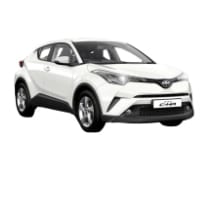
The US House Energy and Commerce Committee this week advanced legislation designed to keep autonomous vehicles safe and promote the advancement of the technology. The self-driving act is billed as the PAVE Act, which expands the existing authorization of the National Highway Traffic Safety Administration to evaluate exemptions from federal motor vehicle safety standards only if there is no reduction in safety and increases the number of vehicles for which exemption may be granted. The exemption will help the advancement of the autonomous driving development by allowing the industry to collect data and help Government to recall self-driving cars for safety reasons. The act is becoming increasingly important as more and more companies and states get involved in the testing of self-driving technology. Ride hailing company, Lyft, this week announced that it formed a self-driving division and will establish a self-driving research facility, named Level 5 in Palo Alto, California.
While the 3rd season of the Formula E is ending this weekend in Montreal, Canada with Renault e.dams set to win it for the third season in a row, two racing car heavy weights this week announced that they would join the series in the 6th season from 2019. Porsche announced this week that it would quit the Le Mans race and join Formula E, following sister company Audi who left the well known 24-hour race in October 2016. The other automaker to join the Formula E circuit was Porsches’ German compatriot and recent Formula 1 champion, Mercedes, who also announced this week that it will join the 2019 series, leaving the Deutsche Tourenwagen Masters to help with funding its participation in the emerging EV racing franchise.
CEO of Royal Dutch Shell Plc, Ben Van Beurden, told Bloomberg in a televised interview that he is ditching ICE vehicles and buying an electric vehicle, all be it a plug-in hybrid Mercedes Benz S500e. The companies CFO already owns a BMW i3. Mr. Van Beurden said “The whole move to electrify the economy, electrify mobility in places like northwest Europe, in the U.S., even in China, is a good thing. We need to be at a much higher degree of electric vehicle penetration — or hydrogen vehicles or gas vehicles — if we want to stay within the 2-degrees Celsius outcome.” He went on saying “If policies and innovation really work well, I can see liquids peaking in demand in the early 2030s and maybe oil will peak a little bit earlier if there’s a lot of biofuels coming into the mix as well.”
The statement comes in the wake of the UK Government’s announcement that it will ban the sale of ICE and PHEV from 2040, joining countries like France, India, and Norway in such a move.
Shell is preparing itself for the shift away from fossil fuels by spending $1 Billion a year in its New Energies business unit.
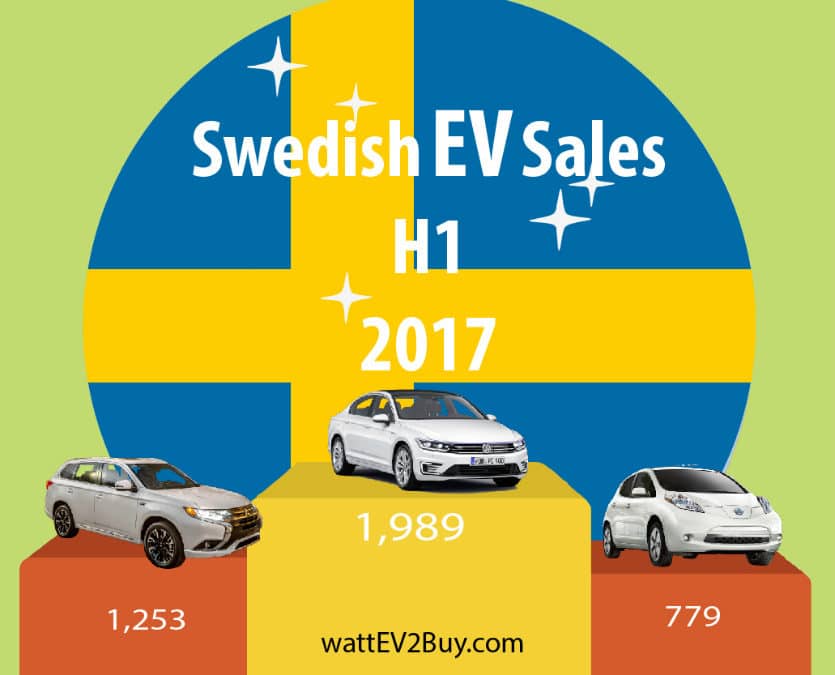
We look at the Top brands and models, the gainers and losers and how the battle between battery electric (BEV) and plug-in hybrid (PHEV) technologies play out in the summary of Sweden EV Sales H1 2017.
The highlights for Swedish electric car sales in H1 2017 was:
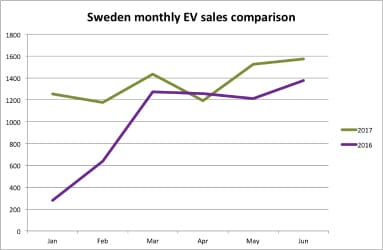
The Top 3 EV brands in Sweden for H1 2017 were VW, new entrant Mitsubishi and BMW. Most EV brands except Volvo and Peugeot showed gains in units sales compared to H1 2016. Hyundai entered the Swedish market with its Hyundai Ioniq BEV. Initial sales for the Ioniq was below average in a market which has a preference for plug-in hybrid electric vehicles. Toyota re-entered the market with the new Prius but failed to get the same traction as it did in other markets. Tesla and Mitsubishi nearly doubled their sales from 2016. Sweden is on of the few markets where Mitsubishi showed positive growth with the aging Mitsubishi Outlander PHEV in 2017 and now makes up 23.24% of all EV registrations in Sweden. BMW maintained its third overall position with the support of its 330e, 225xe, and X5 xDrive models, more than compensating for waning sales in the BMW i3 model series. VW held on to the top spot, mostly due to the VW Passat GTE which accounted for 25% of all EV sales in Sweden during H1 2017.
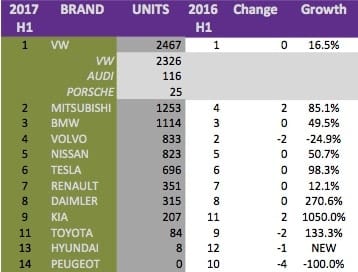
Ten new EV models entered the Swedish EV market in the comparison between H1 2016 and H1 2017. Of the ten new EV models, eight were plug-in hybrids, and only the Tesla Model X made it on to the Top 10 list. Volvo launched two new plug-in models at the end of May in its home market, the Volvo XC60 T8 and Volvo S90 T8 PHEV. The XC60 sold 44 units and the larger S90 31 units. The Nissan Leaf still performed well considering the upgrade is expected early 2018. Most of the Mercedes-Benz models fared well except for its larger S550 and GLE550 models. The Daimler company could however not compete with its compatriot, BMW, who had more models in the smaller end of the scale. The BMW 330e, BMW i3, and BMW 225xe Active Tourer sold 813 units while the Mercedes-Benz B250e and Mercedes-Benz C350e could only muster a combined 130 units. The Tesla Model S still performed well in Sweden as opposed to the general trend where we see the sales flattening out in its main markets.
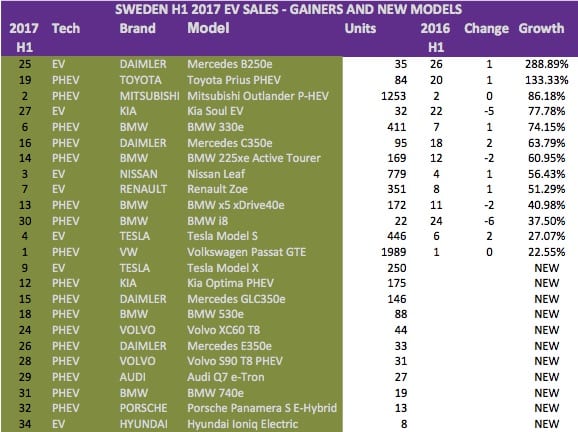
Volvo was the big loser in Sweden during the first half of 2017 despite having a home ground advantage and bringing two new models to market, albeit only in late May. Volvo’s two mainstay plug-in electric cars, the Volvo XC90 T8 and Volvo V60 PHEV, lost nearly a third of their respective sales to brands such as VW, BMW, and Mercedes-Benz.
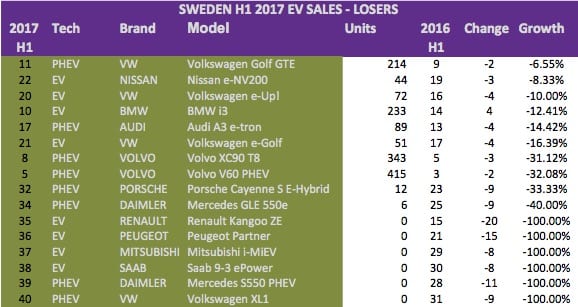
Sweden has a definite preference for plug-in hybrid electric vehicles. Of the ten new models released since the first half of 2016 in Sweden, eight were PHEVs. A total of 5,850 plug-in hybrid vehicles were sold, comprising 72% of the market while only 2,301 pure electric models were sold during the same period. The percentage breakdown of PHEV to BEV in H1 2017 is very similar to that of H1 2016, explaining why most new models released in Sweden were PHEVs despite a halving of the rebate on plug-in hybrids.
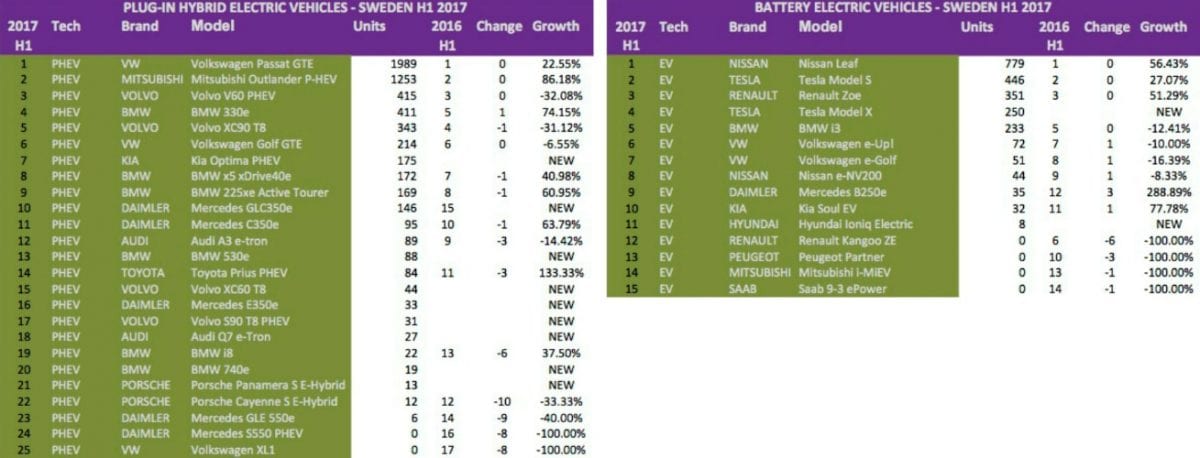
In conclusion, even at a 3.4% of the national fleet (Q4 2016), electric vehicle sales in Sweden remains low compared to its neighbor Norway, which has an EV penetration of close to 30% (Q4 2016). The sluggish performance is linked to the Swedish EV incentive program which has been erratic, linked to a fixed amount of funding which has been depleted a couple of times. Also, the Swedish EV buyer does not get his/her rebate at the point of sale. The Swedish Transport Agency contacts owners after the purchase of the vehicle requesting the completion of a paper process after which they receive the rebate. The rebate of 40,000 kroner (~ $4,500) applied to BEVs and PHEVs up to October 2016 at which time it was halved for PHEVs.
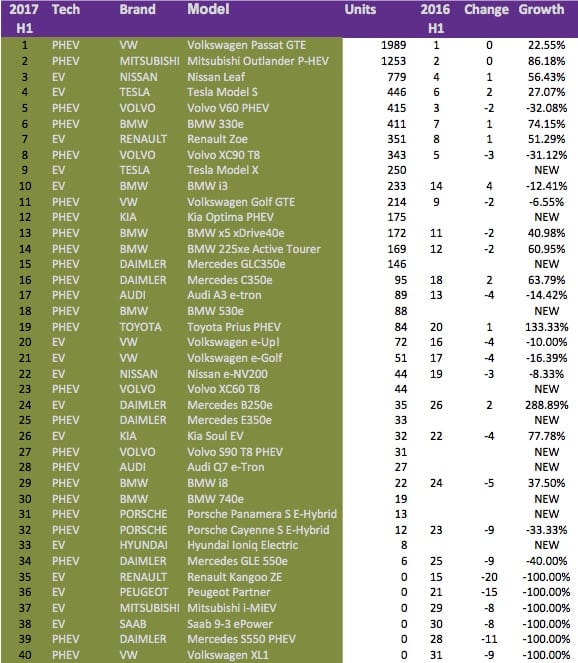
Base data supplied by EV Sales, all calculations, and data representations by wattEV2Buy.
Be sure to check out our new presentation of all EVs since 2010 to gain great insights on all auto brands and their electric vehicle strategies. We have also created presentations per technology type BEV, PHEV, and FCEV.
The page you requested could not be found. Try refining your search, or use the navigation above to locate the post.
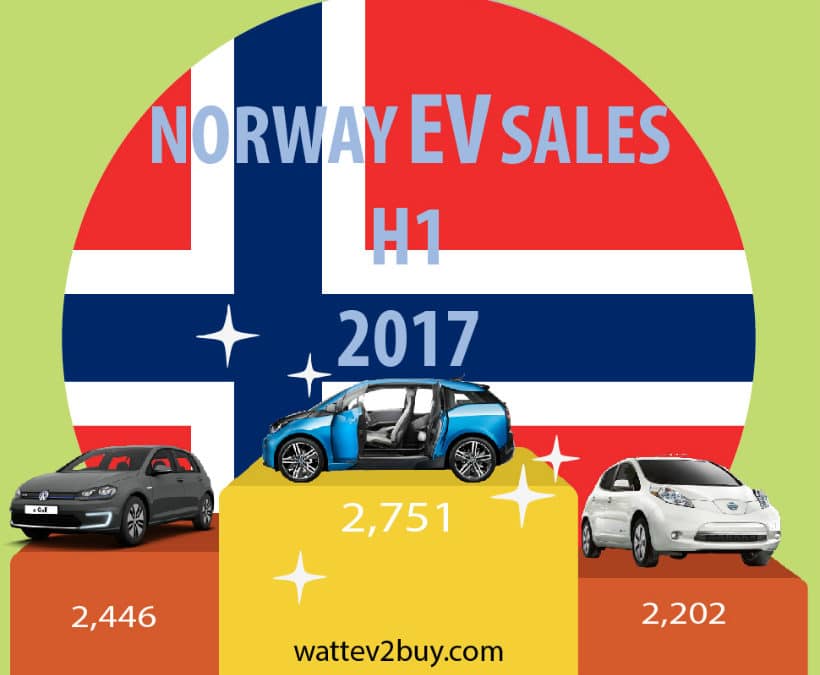
We look at the Top brands, Best and Worst Models and how the battle between battery electric (BEV) and plug-in hybrid (PHEV) technologies play out in the summary of EV Sales in Norway H1 2017.
The highlights for Norwegian electric car sales in H1 2017 was:
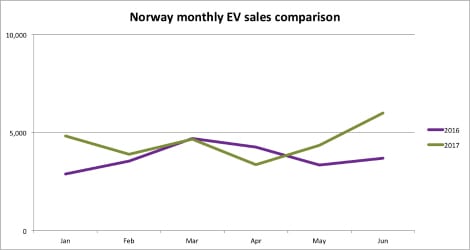
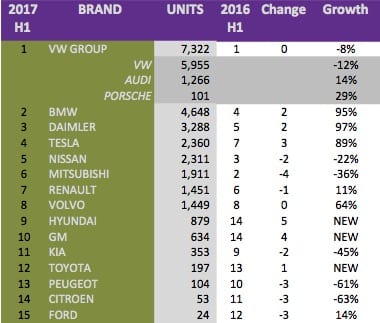 We saw very big changes in the Top 3 electric vehicle brands in Norway with only VW Group retaining its Top position, albeit with lower sales in its mass-market VW brand. Japanese automakers, Mitsubishi and Nissan were pushed from the Top 3 by German luxury automakers BMW and Daimler. Tesla sales also surpassed that of Mitsubishi and Nissan, with a strong performance by the Tesla Model X more than offsetting the slide in Tesla Model S sales. Tesla now commands over 11% of the total EV market in Norway.
We saw very big changes in the Top 3 electric vehicle brands in Norway with only VW Group retaining its Top position, albeit with lower sales in its mass-market VW brand. Japanese automakers, Mitsubishi and Nissan were pushed from the Top 3 by German luxury automakers BMW and Daimler. Tesla sales also surpassed that of Mitsubishi and Nissan, with a strong performance by the Tesla Model X more than offsetting the slide in Tesla Model S sales. Tesla now commands over 11% of the total EV market in Norway.
French automakers Renault, Peugeot and Citroën gave up positions to their peers as Hyundai and GM entered the market with the new Ioniq and Opel Ampera-e (Bolt EV) mass-market EVs. It is disappointing that first movers such as the PSA Group grew too comfortable supplying the same models for the past 5 years without preparing a response to longer range mass-market vehicles. Toyota has not achieved the same stellar sales in Norway with the new Toyota Prius as it did in some of its other markets.
The Top 10 gainers in sales growth over 2016 were mostly plug-in hybrid vehicles (PHEV) while the top selling vehicles by units were mostly battery electric vehicles (BEV). The BMW i3 rose a healthy eight positions and ate into the sales of the VW e-Golf, VW e-Up, VW Golf GTE, Audi A3 e-tron, and Nissan Leaf. Norway is now the second best market, after the USA, for the German manufactured BMW i3 accounting for 8% of all electric vehicles on the country’s roads. The Tesla Model X performed very well, helping Tesla to nearly double its sales in Norway. The rise of the Model X, now the best performing luxury EV in Norway, came at the expense of the BMW X5 xDrive and Mitsubishi Outlander. Luxury brands Daimler and BMW‘s large selection of PHEV models performed well in Norway with the Mercedes GLC350e helping Daimler to be the leader in the luxury class over BMW. It is only Daimler’s lack of an answer to the BMW i3 that kept the automaker in the third spot overall.
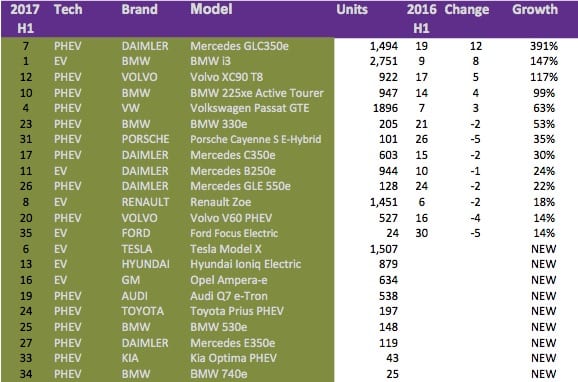
The VW brand sold 1,540 units less than last year across the VW Golf GTE, VW e-Golf, and VW e-Up models. The VW Group lost nearly 2,000 units in total if one should factor in the sales loss from the Audi A3 e-tron. The biggest overall loser was the Mitsubishi Outlander PHEV which sold 1,040 units less than the same period in 2016. The Tesla Model S is following the same trend as we see in many other countries, losing 31% or selling 388 units less than last year.
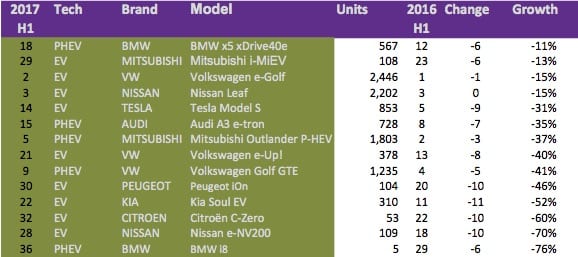
Pure electric vehicles (BEVs) extended their lead over plug-in hybrid vehicles (PHEV) to 20.6% from 17.3% in H1 2016 despite having fewer models to offer. A total of 14,753 BEVs sold in the first-half of 2017 in Norway compared to 12,231 PHEVs. For our calculation, we included the BMW i3 REx as a BEV since we don’t have an accurate breakdown of BMW i3 sales between the BEV and range extended version.
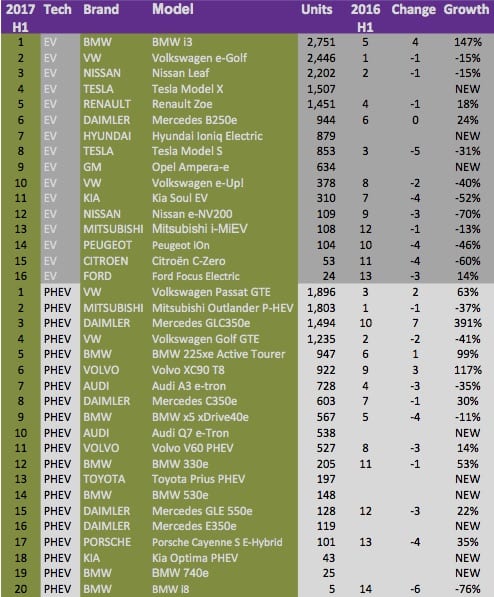
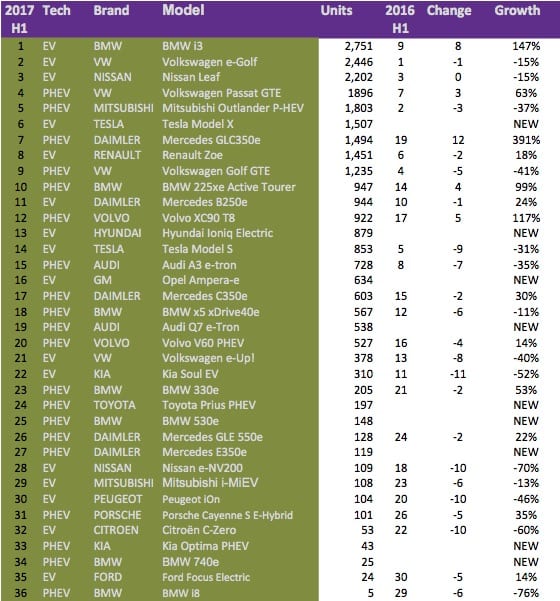
Be sure to check out our new presentation of all EVs since 2010 to gain great insights on all auto brands and their electric vehicle strategies. We have also created presentations per technology type BEV, PHEV, and FCEV.
The page you requested could not be found. Try refining your search, or use the navigation above to locate the post.
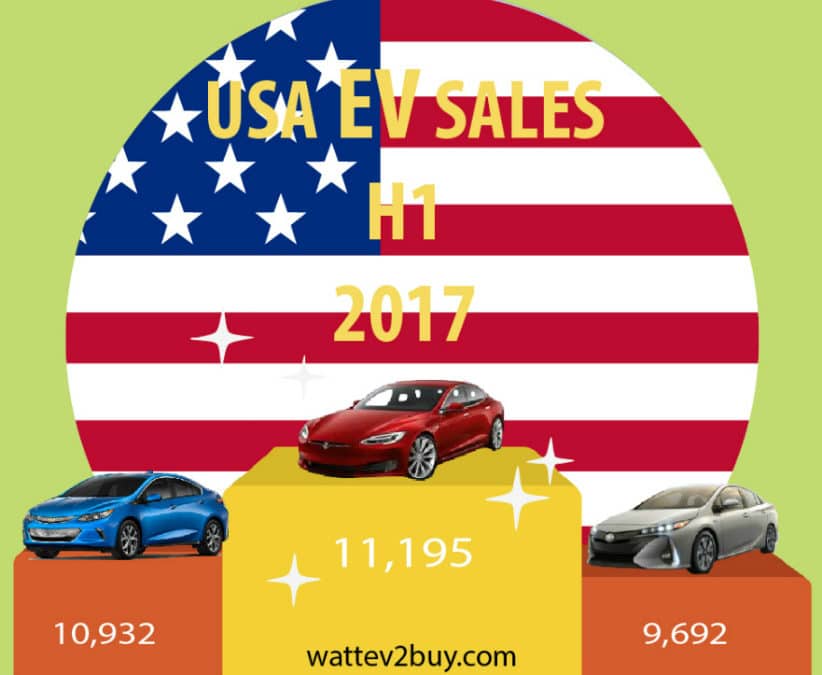
We look at the Top brands, Best and Worst Models and how the battle between battery electric (BEV) and plug-in hybrid (PHEV) technologies play out in the summary of USA EV Sales H1 2017.
The highlights for USA electric car sales in H1 2017 was:
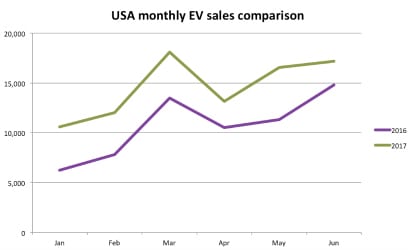
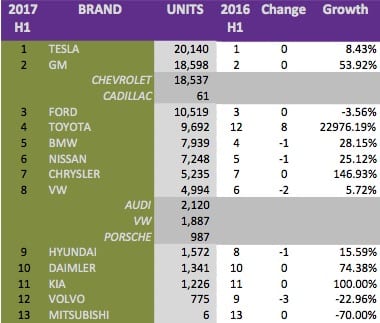
There are no surprises in the Top 3 EV brands with Tesla holding on to its lead over GM due to a 24% rise in Tesla Model X sales. GM could not dethrone Tesla even with a new model, the mass-market Chevrolet Bolt EV up its sleeve. Improved sales in the 2nd Quarter from the Ford Fusion Energi and C-Max Energi helped the brand retain its third position fighting off the strong performance of Toyota with the new Toyota Prius which was placed third at the end of the first quarter.
Most brands showed improved sales growth over the first half of the year with only Ford, Volvo, and Mitsubishi showing declining sales. The Volkswagen Group showed a declining trend as the year progressed and mustered the lowest growth. The declining fortunes of the German automaker can be attributed to the Volkswagen e-Golf not being able to compete on range with the new mass-market Chevrolet Bolt being sold in the same price bracket. Chrysler showed the highest growth after Toyota buoyed by the new Chrysler Pacifica and great specials on its compliance car, the Fiat 500e. The results might have been better for the US automaker, but the Chrysler Pacifica launch was delayed and then impacted by recalls and plant closure due to battery problems.
Most of the existing models showed growth lower than the overall growth due to the big number of new models to the market. Surprisingly the Ford Focus and Fiat pure electric models outperformed the market showing that the public is becoming more comfortable with range issues and the continuously improving charging infrastructure is starting to have and effect on top of the financial incentives making EVs appealing.
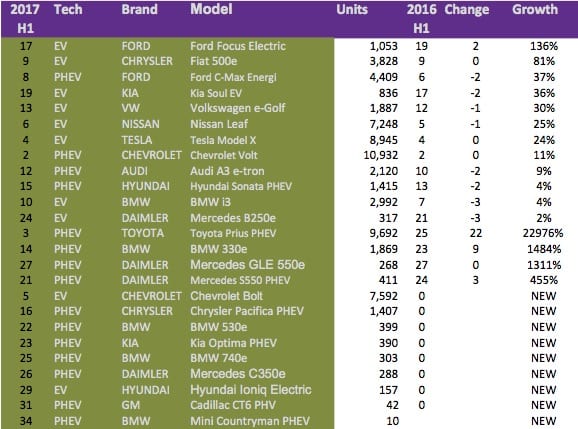
European plug-in vehicles were the biggest losers in this half of 2017 with a number of the luxury PHEV models losing big. Volvo and BMW saw some of their relatively new models losing steam. Both the BMW x5 xDrive and Volvo XC90 T8, released in 2016, lost market share in favor of the Tesla Model X. The Tesla Model S sales have flatlined although it remained the top selling BEV model. It will be interesting to see how the new Daimler Smart ForTwo ED fares in the second half of 2017. The German automaker is relaunching the brand as electric only in the USA and Canada from this summer and will offer a slightly improved model at a marginally reduced $23,800 starting price before incentives.
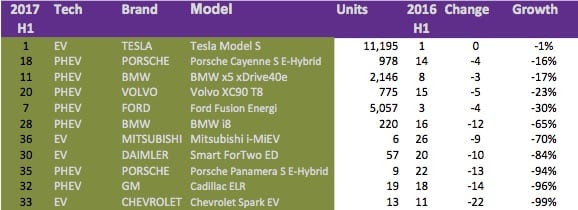
Battery electric vehicles are still maintaining its lead over plug-in hybrids albeit at a lower margin. BEVs took six positions in the Top 10 EV sales for the USA in the first half of 2017. The ever increasing number of plug-in models benefits the technology in the short term as it competes with only a handful of pure electric models. The Plug-in hybrid category benefited mostly from the release of the new Toyota Prius and to a lesser extend the Chrysler Pacifica. The Tesla Models X and S constitute nearly 44% of all BEV models showing the company’s dominance in the sector. The commanding position will improve even more with the release of the Model 3 in the second half of 2017 which might add about 40,000 units depending on the production ramp-up. The release of the Tesla Model 3 and new Nissan Leaf, expected by the end of the year, should help pure electric vehicles outperform the more dirty plug-in hybrids in the second half.
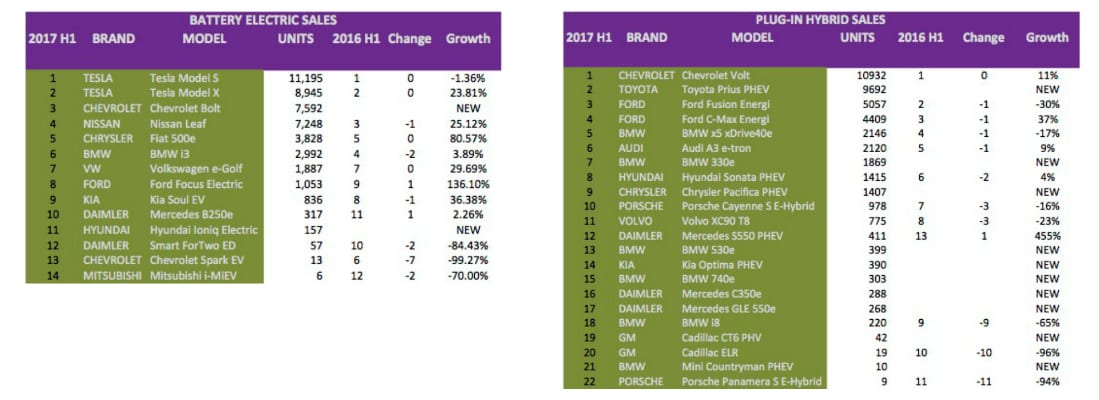
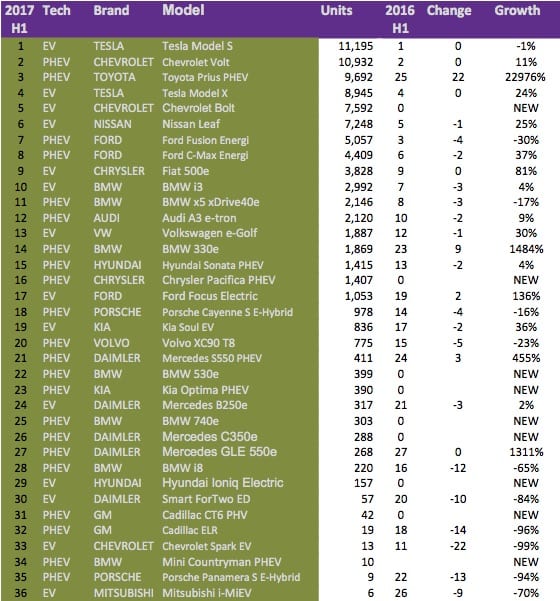
Be sure to check out our new presentation of all EVs since 2010 to gain great insights on all auto brands and their electric vehicle strategies. We have also created presentations per technology type BEV, PHEV, and FCEV.
The page you requested could not be found. Try refining your search, or use the navigation above to locate the post.
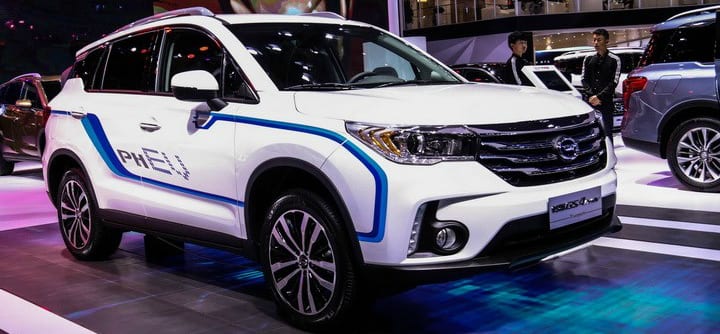
The relatively young GAC Motors is one of China’s best-respected vehicle brands. The company has a defined EV strategy and will add three models to its EV fleet in 2017.
Guangzhou Automobile Group Co, Ltd. founded in 2005 has various Joint Ventures with large international auto manufacturers such as Toyota, Hino, and Honda. Wanxiang Group, a large auto-parts manufacturer, and owner of Karma Automotive, previously known as Fisker Automotive, is one of the founding shareholders.
GAC MOTOR established its New Energy division at the end of 2015. The division focused on developing its R&D and production to penetrate the growing Chinese market for EV’s. The New Energy strategy is supported by GAC Group’s “1513” new-energy development strategy which makes the development of an R & D platform, R & D of core technologies a key development direction for its products.
GAC has international ambitions and aims to establish sales and service networks in 14 countries, including North America, Africa, South and Eastern Europe and South East Asia. GAC has reaped the rewards of creating a world-class vehicle brand and sold more than 380,000 vehicles in 2016, compared to around 194,000 the previous year, and has achieved 80 percent compound annual growth rate from 2011 to 2016. The company expects to sell 500,000 cars in 2017 and plans to produce 1 million cars in 2020. The Group targets 200,000 new energy vehicles in 2020 and meeting fuel consumption targets of 5.0L/100Km over its model range. In 2016 GAC Trumpchi delivered a total of 3,378 units of its GA5 PHEV model, an increase of 167% on 2015.
To support its strategy, Guangzhou Automobile Group passed two resolutions impacting EV development at its Board of Directors meeting on June 5th, 2017.
GAC Motors are also pursuing other electric mobility solutions. In February 2016, Guangzhou Lixin Taxi Company owned by GAC Access launched more than 200 Levin twin-engine HEVs into Guangzhou taxi market. Also, GAC Group fully mobilizes the creativity of various business sectors and is actively devoted to new energy and energy conservation and environmental protection. GAC Motors and BYD established a JV in 2015 to co-operate in EV development. As a result, the company launched 400 pure electric buses produced by GAC BYD New Energy Bus Co., Ltd. into Guangzhou public transport system to provide services for citizens. The JV company is 51% owned by GAC and has a registered capital of 300m RMB.
Click through to the GAC Motors page on wattEV2Buy to explore the past, present and future EV models by the Chinese automaker.
Stay tuned to wattEV2buy and follow the rest of our weekly series on Chinese EV brands.
The page you requested could not be found. Try refining your search, or use the navigation above to locate the post.

EV sales in the USA are up 43% Year-to-Date after sales in May resulted in it being the second best month for electric cars for the year 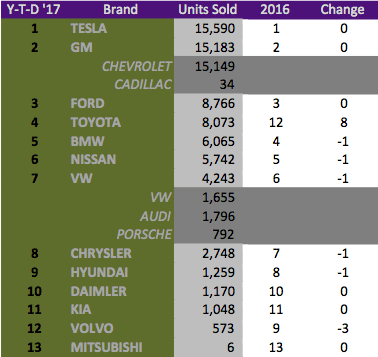 so far. May 2017 sales outperformed May 2016 with a 46% increase. The tussle between BEVs and PHEVs is to close to call as pure electric vehicles continue giving ground on the lead at had over PHEVs, with PHEVs outselling BEVs in May with 8,325 units vs. 8,243 pure electric vehicles which include the BMW i3 REx.
so far. May 2017 sales outperformed May 2016 with a 46% increase. The tussle between BEVs and PHEVs is to close to call as pure electric vehicles continue giving ground on the lead at had over PHEVs, with PHEVs outselling BEVs in May with 8,325 units vs. 8,243 pure electric vehicles which include the BMW i3 REx.
The best performing electric vehicle for the month was the Toyota Prius, dethroning the Chevrolet Bolt for the first time this year. The Tesla Model S also dropped out of the top 3, a rare occurrence, making way for its sibling, the Tesla Model X. The Hyundai Ionic and Chrysler Pacifica both climbed five or more positions for the year, with the Chevrolet Bolt increased its units sold with 21% on April but remaining in the 5th place overall for the year. The big losers for May 2017 were the Mercedes C350e, Audi A3 e-tron, and Ford Focus Electric.
The Top 3 brands remained the same as this time last year with Tesla, Chevrolet and Ford taking the top three positions. The rest of the brands had to make way for the rise of Toyota, taking the 4th place. Volvo gave up the most ground, falling from 9th to 12th spot.

Toyota confirmed this weekend that it divested from Tesla as it exited the co-operating agreement the companies had on electric vehicle technology. Toyota acquired 3.15% in Tesla in 2010 for $40.5 million, a stake which would have been worth $1.75 billion at Friday’s close. According to the Japan Times Toyota announced that the sale of the stake, which happened in trances between October 2014 and the end of 2016, is “a part of a regular review of business alliances.” The partnership resulted in the development of an electric Toyota RAV 4, which was abandoned as the company changed course away from EVs to hydrogen fuel cell technologies.
The Indian Government’s Department of Energy posted a blog in which it reiterates its ambition to only sell EVs by 2030 through its National Electric Mobility Mission Plan on which we reported on in Week 17. The Government’s plan set a target of between 6 and 7 million units by 2020 already, which seems overly ambitious as EV sales have yet to pick-up in the country. One if its largest automakers Mahindra and Mahindra last week announced that it only now plans to increase its battery production capacity from 500 units to 5,000 a month, a far cry from what should be needed if it wants to produce its fair share of 6 million units. The blog sees that EVs will reach parity with ICE vehicles by 2022. Bloomberg New Energy Finance in a report last week saw this only happening in 2025. Automakers such as Mahindra is reluctant to overly invest in EV manufacturing infrastructure while the prices of ICE cars remain cheaper than EVs in a country where the consumer is very price sensitive. The Indian Government is yet to definitively announce what financial contribution it will make towards achieving the goals, other than saying it acknowledges that it will need to carry the industry for the first three years.
Chinese Premier, Li Keqiang, and German Chancellor, Angela Merkel met on Thursday to discuss various trade issues between the two countries, amongst others the impact of the China’s ZEV-like quota on German automaker’s expansion plans in the Asian country. The Chinese Government proposed that car manufacturer had to achieve a level of 8% EV sales by 2018. Although not confirmed Reuters on Friday reported that the Chinese Government agreed to delay the quota to 2019 for German companies but that they should ramp up EV deliveries at a later date.
As the electric vehicle sales in neighboring Norway climbed 30% year-on-year for the month of May the CEO of Russia’s largest oil company, Rosneft PJSC, Igor Sechin denounced EVs as overrated. Mr. Sechin was quoted by Bloomberg during a speech at the St.Petersburg International Economic Forum saying Tesla is overvalued and EVs are “not as popular as had been expected” in Europe’s biggest economies. Mr. Sechin went further saying “The market’s assessment of the prospects of electric car producers, in our view, is significantly overestimated,” and that “Until the electric transport industry becomes as user-friendly and attractive for consumers as the cars with internal combustion engines, the prospects for electric vehicles remain largely uncertain.” Rosneft that had 2015 revenues of nearly $100 billion market value was clipped by that of Tesla at the end of May 2017. Tesla shares were up nearly 60% for the year while Rosneft was down 20%.
We acknowledge Donald Trump leaving the Paris Climate Pact but took a decision to rather report on other EV related stories of the week.
Interested in learning more about Chinese electric vehicles? Download our fun and easy app below, flick the China switch and swipe left the models you don’t like, right the ones you do, enter the chat rooms and share your thoughts with the community.
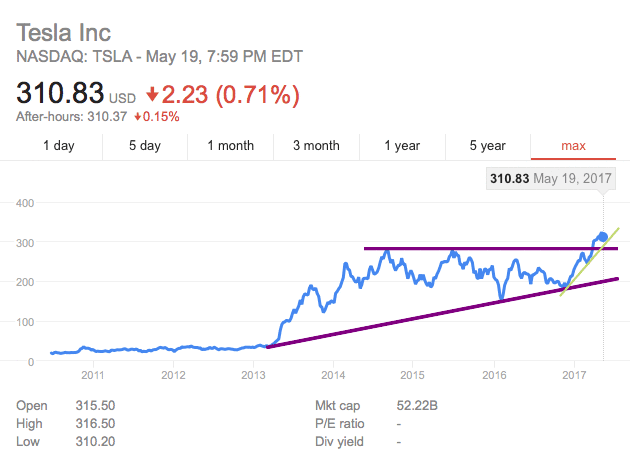
#1 – Where to next for Tesla’s share price after Morgan Stanley downgrade?
On the third of April, I predicted that Tesla’s share price will at least reach a first target of $320 after the breakout of the resistance at $290. This week Morgan Stanley analyst Adam Jonas, one of the pro-Tesla investment houses of late, downgraded its position to “equal-weight” from “overweight”, sending the stock down 3% and closing the week at $310.83 from a high of $325.22. The Morgan Stanley call is purely based on the Model 3 deliveries, which it now sees lower at a higher associated cash burn on R&D and Capex.
Tesla CEO Elon Musk also referred to the high share price in a telephonic interview this week with the Guardian where he was quoted saying “I do believe this market cap is higher than we have any right to deserve”. Before hitting the sell button it is important however to read Elon’s statement in the correct context, that investors price the share based on expectations not on past performance. The statement was made in a similar vein as a tweet by him in April on the topic where he responded “Tesla is absurdly overvalued if based on the past, but that’s irrelevant. A stock price represents risk-adjusted future cash flows.”
Technically I still hold out that there is more in the share price and that the count in the breakout formation at $290 in April can see the price go as high as $400, but at least $380 with a stop loss at $285. Should the stock fall through $285 look for buying opportunities again in the lower $200’s. Fundamentally, however, it all boils down to Tesla’s ability to surprise the market on Model 3 deliveries, which everyone and its dog seems to doubt. Watching the recent Ted interview of Elon Musk and listening to the Skype interview of Tom Mueller, Chief Propulsion Technology Officer at SpaceX, with a group of astronomists at the New York University Astronomy Society my money is on Tesla surprising the market on the upside, barring no technical issues arise in the new plant. Read extracts from Tom Mueller interview below and decide for yourself.
And now we have the lowest-cost, most reliable engines in the world. And it was basically because of that decision, to go to do that. So that’s one of the examples of Elon just really pushing— he always says we need to push to the limits of physics. Like, an example I’ll give is, on the car factory; you know, a car moves through a typical factory, like a Toyota or a Chevy factory; a car is moving at you know, inches per second. It’s like, much less than walking speed. And his thoughts are that the machinery, the robots that are building the car should move as fast as they can. They shouldn’t be moving so fast you can’t see them. That’s why you can’t have people in there, because they’d get crushed; people move too slow. That’s the way he thinks. “So, what are the physical limits of how fast you can make a car?” He looks at videos of like, coke cans being made, and things like that, where you can’t even see them; it’s just a blur. And, you know, the puck of aluminum, cut it up, deep-draw, fill it with coke, you put the lid on, you put the lid on it; it’s just like going down the assembly line so fast you can’t even see it. And Elon wants to do that with cars.
That’s just the way he thinks. Nobody else thinks that way. And that’s why he’s going to kill the industry; cars also. Because it’s just going to make these cars— basically, you can make, you know, ten times as many cars in the same size factory if you do it that way. And that’s, you know, the major cost of the car is not the material in the car; it’s the factory that builds the car. So that’s the way he thinks. He looks at it from first principles, like “Why does a car cost so much to make?” Well, you’ve got this gigantic piece of real estate, and all these employees in this gigantic building; and you can only make so many cars in this building. You need to make more cars in the same building with the same number of people. And that’s what they’re working on at Tesla.
#2 – NIO EP9 Shatters records set by all production car at Nürburgring
In November 2017 the NIO EP9 broke the record as the fastest Electric Vehicle around the challenging German circuit, the Nürburgring in a time of 7:05:12. The start-up brand NIO then proceeded to complete the world first autonomous lap at a speed of 160 mph around the America‘s Track in Austin Texa. As if all these records weren’t enough the NIO EP9 this week shattered all records for production vehicles set around the around the Nürburgring. The record means electric vehicles are now officially faster than combustion based production cars. The NIO EP9 set a new lap record in a time of 6:45.90 around the 12mile long track, a full 6 seconds faster than the previous record set by the Lamborghini Huracan performance. See the video of the lap here. The weirdest thing about the lap is that the noise, or lack of it, does not give you the impression of speed but more the feeling that its a Scalextric toy race car.
#3 – Toyota still not fully behind electric vehicles
Toyota still has not completely put its full weight behind electric vehicles is it continues pursuing Hydrogen Fuel Cell (HFC) technology. The Japanese automaker this week announced that it signed a Memorandum of Understanding with ten companies to jointly develop 300 HFC stations of the next 10 years in the country. Even though Toyota pioneered the first mass-market Plug-in Hybrid the company forsook the lead it had on the technology for a hydrogen future. Last year the company admitted that electric vehicles have some relevance by creating a new division to build its first pure electric vehicle. The CEO, Akio Toyoda personally took leadership of the division but the company has not changed its strategy away from the HFC path with it sees as the relevant technology from 2025. The HFC strategy is in conflict with most recent analysis which sees electric vehicles becoming the dominant technology from 2025, some forecasts this week even says it will completely replace combustion engines.
#4 – Electrified public transport gets a leg up this week
As electric vehicles become more popular so does the application for other modes of transport. For long the Chinese automakers, such as BYD and Changjiang had the monopoly on electric buses, but this week we saw more automakers enter the segment. The challenge with electric buses, other than cars is that you need ultra fast charging of huge batteries, and these huge batteries add weight to the vehicle.To be equipped with a 256kWh battery. Two automakers outside of mainland China this week announced that they are entering the electrified bus market.
Hyundai announced that it would develop an electric bus for the local market next year. The bus is expected to be equipped with a huge 256kWh battery.
Mercedes-Benz released the following statement at the Global Public Transport Summit (GPTS) in Montreal
In parallel with the optimisation of the diesel drive system, Mercedes-Benz is working hard on the all-electric-powered and locally emission-free city bus. The all-electric Citaro is due to go into series production in the coming year – prototypes are already undergoing testing on the roads. The electrically powered Citaro will open up a new chapter in electric mobility, because Mercedes-Benz is not looking at the city bus in isolation, but as an integral part of a highly efficient transport system.
#5 – Volvo to stop developing diesel engines
Volvo‘s CEO Hakan Samuelsson this week in an interview with the German publication, Frankfurter Allgemeine Zeitung, confirmed that the Chinese-owned Swedish company would utilize the springboard offered by Tesla and focus on electric drivetrains and 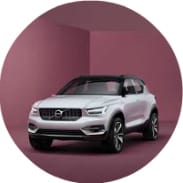 stop developing
stop developing 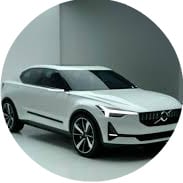 diesel engines. The company is expected to bring its first pure electric vehicle to market by 2019. The vehicle is expected to be based on one of its two Volvo 40 concepts revealed earlier this year shown here. Though it’s not decided if it would be an SUV or sedan, the electric car will be developed on the company’s new Modular Electrification Platform (MEP) and build in China. The EV will have a minimum range of 250 miles and priced around $40,000. Mr. Samuelsson acknowledges the role Tesla played in creating commercial interest for high-quality well-designed electric vehicles, an area aligned to Volvo’s strategy. Volvo just released a new improved range of diesel and petrol engines and with European regulation potentially adding as much as $340 per engine from 2020 diesel engines would just be too expensive to produce according to the CEO.
diesel engines. The company is expected to bring its first pure electric vehicle to market by 2019. The vehicle is expected to be based on one of its two Volvo 40 concepts revealed earlier this year shown here. Though it’s not decided if it would be an SUV or sedan, the electric car will be developed on the company’s new Modular Electrification Platform (MEP) and build in China. The EV will have a minimum range of 250 miles and priced around $40,000. Mr. Samuelsson acknowledges the role Tesla played in creating commercial interest for high-quality well-designed electric vehicles, an area aligned to Volvo’s strategy. Volvo just released a new improved range of diesel and petrol engines and with European regulation potentially adding as much as $340 per engine from 2020 diesel engines would just be too expensive to produce according to the CEO.

Now that all the Q1 data is in we can do a detailed dissection of the hottest quarter in EV history in which nearly 200,000 electric vehicles was sold. The headline data is that nearly 180,000 EVs were sold in the top 10 EV countries. Battery Electric Vehicles (BEV)  outperformed Plug-in Hybrid Vehicles (PHEV) by a long shot. A total of just over 106,000 BEVs were sold while only around 70,000 PHEVs moved off the dealership floor in the top 10 countries.
outperformed Plug-in Hybrid Vehicles (PHEV) by a long shot. A total of just over 106,000 BEVs were sold while only around 70,000 PHEVs moved off the dealership floor in the top 10 countries.
One of the standout data points is USA EV sales which overtook China as the best market for electric vehicles in Q1, making the USA the top EV country in Q1. The worst performer was The Netherlands, who fell out of the top 10. The Netherlands disappointing performance over the last couple of quarters does not bode well for the European country was seen, next to Norway, as one of the proponents of the technology. Only last year still did the Dutch Government contemplated a goal to be 100% electric by the middle of the next decade. It is unclear what caused the drop in EV sales in the Netherlands.
When comparing this quarter’s EV sales by country to their respective totals for 2016 one can see that the pace of EV sales picked up in most. If one should expect that by the end of Q1 EV sales should equate to roughly 25% of 2016, it is only China and The Netherlands that are underperforming. Chinese EV sales have lagged in January due to technical factors including a clampdown on EV subsidy fraud and the annual Chinese holiday, in which most industries shut down. Chinese EV sales have picked up the pace in the following months and the quarter still ended up 30% over the same period of the previous year. It can be concluded that EV sales for the first quarter in China are historically weak and Q1 2017’s performance is by now way an indication of a trend. Furthermore, the Chinese Government last week announced a plan to dominate the electric vehicle sector which should help the country to regain its stature. Japan, on the other hand, has picked up the strongest pace and has already achieved EV sales equal to 59% of its total 2016 sales. The Japanese EV market has the least variety of EV models available to consumers, and it is anticipated that the introduction of more models will stimulate the market further. Germany is the second best performer helped by a 77% improvement in EV sales on a year-to-year basis.
The top EV brand in the Top 10 EV Countries is Tesla for the second year running. Tesla announced in its April trading update that it sold just over 25,000 Models S and X globally. It is important to note that the figure repo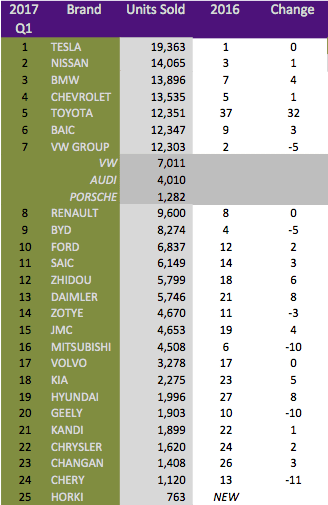 rted includes vehicles being shipped, while country sales data shows vehicles registered. Toyota is back in the Top 10 list of EV brands on the back of a well-received new Toyota Prius. Chevrolet did not shoot the lights out with its new mass-market EV, the Chevrolet Bolt / Opel Ampera-e. Most of GM’s sales came from the Chevrolet Volt PHEV. The company is criticized for producing a limited amount of the Bolt and is being labeled as a compliance company for that, a term used for auto manufacturers that only sell EVs in Zero Emission states to gain credits. The big losers included VW, BYD, and Mitsubishi. BYD has been the Top EV manufacturer for 2015 and 2016 globally and was at the number three position for most EVs sold since the start of the decade. Competition from the likes of BAIC and SAIC is the main reason for the companies bad performance. Up til 2016, BYD had the advantage of being first to market, but some new models that can compete on performance and quality with BYD entered the market since 2016. (This sentence could very well be used for Tesla in a couple of years). Mitsubishi fell a staggering ten places as the company has not updated its popular Outlander PHEV or introduced new models as a replacement.
rted includes vehicles being shipped, while country sales data shows vehicles registered. Toyota is back in the Top 10 list of EV brands on the back of a well-received new Toyota Prius. Chevrolet did not shoot the lights out with its new mass-market EV, the Chevrolet Bolt / Opel Ampera-e. Most of GM’s sales came from the Chevrolet Volt PHEV. The company is criticized for producing a limited amount of the Bolt and is being labeled as a compliance company for that, a term used for auto manufacturers that only sell EVs in Zero Emission states to gain credits. The big losers included VW, BYD, and Mitsubishi. BYD has been the Top EV manufacturer for 2015 and 2016 globally and was at the number three position for most EVs sold since the start of the decade. Competition from the likes of BAIC and SAIC is the main reason for the companies bad performance. Up til 2016, BYD had the advantage of being first to market, but some new models that can compete on performance and quality with BYD entered the market since 2016. (This sentence could very well be used for Tesla in a couple of years). Mitsubishi fell a staggering ten places as the company has not updated its popular Outlander PHEV or introduced new models as a replacement.
The Top 10 EV models are still lead by the Nissan Leaf, a phenomenal performance by the 7-year-old EV. The Toyota Prius replaced the Tesla Model S in the top two while the Tesla Model X performed the best of the 2016 Top 10 cohort. Newcomers Chevrolet Bolt, BAIC E-180, and the Toyota Prius replaced the BYD e6, BYD Tang and Mitsubishi Outlander in the Top 10 EV models list for Q1.
Please use the comment section below to share your thoughts on the EV market.
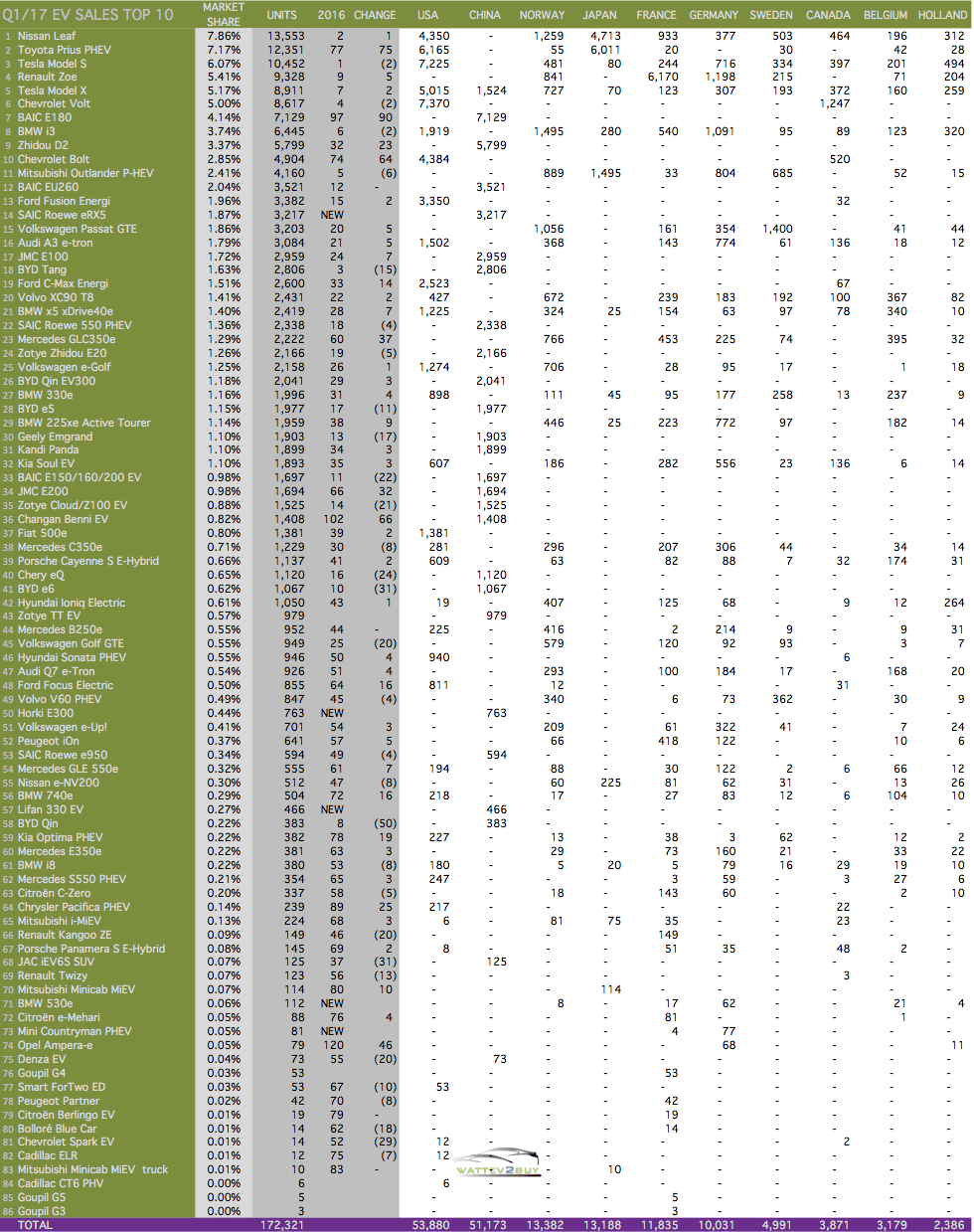
Note on data: The detailed data above does not include the UK, who keeps their EV data more secret than Donald Trump does classified information.
The page you requested could not be found. Try refining your search, or use the navigation above to locate the post.
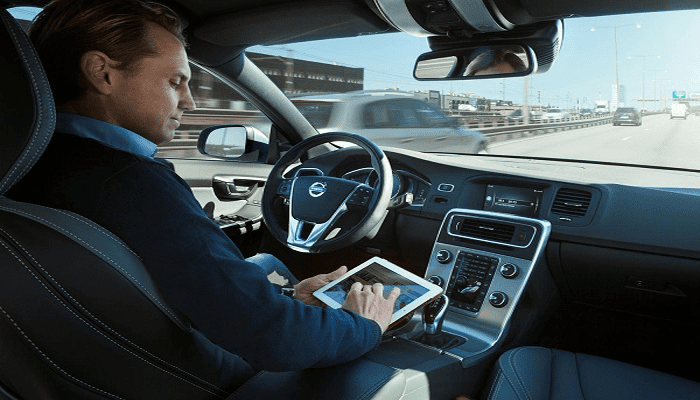
A slew of self-driving pilot programs has been announced recently, the latest being Delphi. The auto parts company previously owned by GM announced that it would roll out self-driving taxis in the USA this year. Delphi is already piloting a program in Singapore where it pilots an Audi SQ5, kitted with 26 sensors. The pilot would be extended to three vehicles in June and is done in conjunction with the Singapore government where the company hopes to have operating taxi service within three years. According to Automotive News it is anticipated that Delphi will host the US pilot in either Pittsburg or Boston and that services would commence in September 2017.
Delphi’s pilot program allows passengers to see what the cars “brain” sees on a tablet, which it calls its “comfort cam”, soothing first-time users of the service. Already speculation is rife that Intel, which just last month paid a staggering $15 billion for Isreali autonomous tech company, Mobileye, would acquire Delphi. The three companies are already integrating their technologies to provide autonomous systems for car manufacturers, as soon as 2019.
Delphi would extend the pilot to Europe in the 3rd quarter and will switch its test vehicles to an undefined electric vehicle by 2018. The regulatory environment for public testing eased last week as Germany passed a law allowing for the public testing of autonomous vehicles.
Competitors, Lyft and Waymo also signed a partnership agreement this week. Waymo, previously know as Google’s self-driving program is already piloting Chrysler Minivans and Lexuses in Phoenix. The company last month invited people living in South East Phoenix to apply for the program, allowing the participant to hail a ride via a mobile app for local trips. Already as much as 10,000 such rides have been completed by Google staff. Waymo announced in April that it would increase its autonomous fleet from 100 to 600 Chrysler Pacifica minivans. It is no surprise that Waymo did not partner with Uber since Waymo claims that Uber stole some of its technology in an ongoing court case between the two companies. Reuters reported that according to Lyft the transaction is not exclusive, leaving the door open for other partnerships such as Lyft’s shareholder GM.
GM paid $500 million last year for a stake in the USAs number two ride-sharing company; the automaker also acquired Cruise Automation to spearhead its autonomous vehicle strategy. GM is very aggressive in the autonomous space, trying to carve out a lead to make up for ground lost to newcomers such as Tesla. GM is spending vast amounts of money to this end, for instance paying $1.1 billion to acquire its second Y Incubator company, the Italian based OSVehicle, to develop a self-driving “Vehicle-as-a -Service” (VaaS) platform. GM’s efforts are seeming to pay off as the respected research firm, Navigant, recently ranked it and Ford at the top of the self-driving leaderboard.
Companies like Delphi, Intel, and Nvidia, are hoping to sell their driverless systems to automakers in what is expected to be a market of around $100 billion within the next couple of years. BMW last week unveiled 40 BMW 7-series equipped with Intel’s driverless technology. The test, using the specially converted autonomous 7-Series is part of the German company’s project that will see 155 million test miles driven. Nvidia, an early front-runner in the self-driving tech space lat week, announced that Toyota would use its autonomous microchip built on Nvidia’s artificial intelligence platform called Drive PX. Both Daimler and Audi have already partnered with Nvidia on its Drive PX system.
Precursors to larger ride sharing and hailing services would be regulation, computing infrastructure, and connectivity. Governments would have to enact regulation to allow driverless cars while processing power and data centers need to be increased many fold to accommodate driverless technology. So also is 5G connection a requirement, daily use of an average self-driving car would be four terabytes of data.
In February we provided a summary of the disengagement reports by companies doing public testing on Californias’ roads. Only 10 of the permitted 20 companies filed reports, this number would definitely increase in 2017 judging from all the pilots announced recently. The pilot programs currently in action are mostly for level three and four autonomy and are expected to be commercially available from 2020 onwards. Even though it is expected that the Tesla 2018 models would have level five compliant hardware installed full autonomy is only expected in the latter half of the next decade.
The video by BMW below provides a short overview of the different autonomous driving levels.
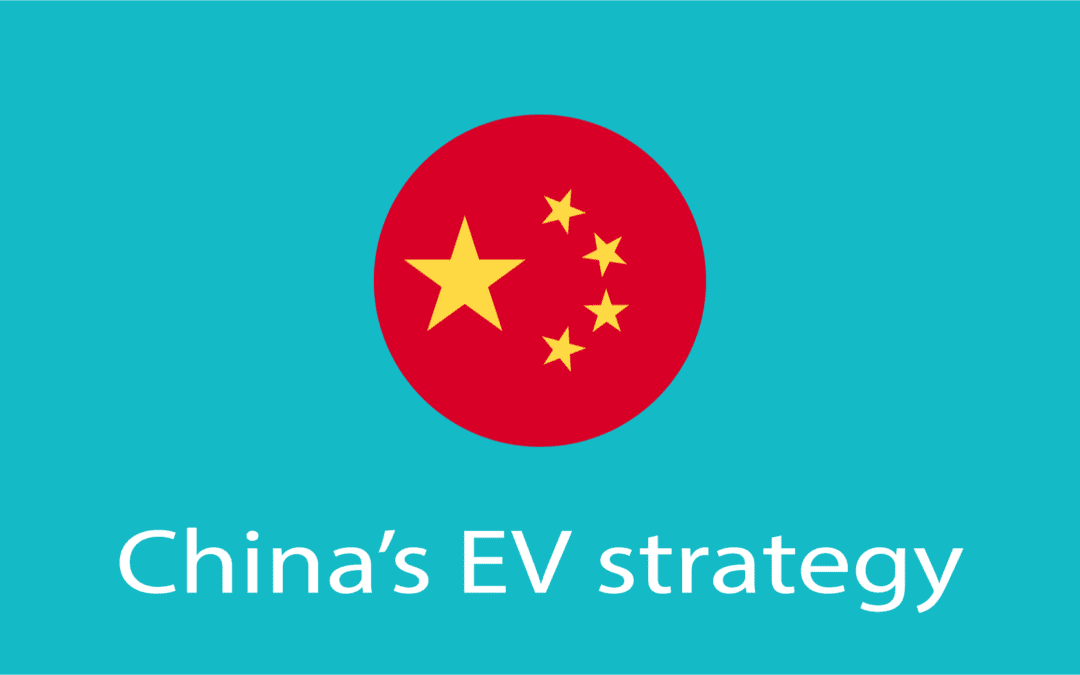
The Chinese Government released its long-term development plan for the automotive sector on the 25th of April 2017, setting out the China EV strategy. The plan, presented by the Ministries of Science and Technology and Ministry of Industry and Information Technology in conjunction with National Development and Reform Commission, sets out how the country will ramp up the local EV sector and dominate the world market.
If successful the Chinese auto sector can leapfrog the dominance of the big auto companies, such as Toyota, VW, BMW, Daimler, Ford, and GM. Big Auto has missed the boat on electric vehicles and therefore continue to downplay the technology as only a niche sector. Management boards of big auto companies are flip-flopping strategy as they try and come to grips with how to enter the market and to what extent they should invest in research in technology. BMW last week announced that EVs constituted 3% of its total sales for the first quarter of 2017 after a jump in EV sales of 50% (Top 5 EV News Week 18). With the release of the data, the company set out how it will introduce more models. The news from BMW is in stark contrast from news only six months earlier when the Board grappled with if it should pursue EVs at all (Top 5 EV News Week 49  2016). In the USA we have recently seen how newcomer Tesla is valued above Ford and GM by investors. The response by Big Auto and other detractors of EVs was that this is a temporary phenomenon, arguing that Tesla hardly produces one tenth of the vehicles any of the top brands does. If one look at total sales of Battery Electric Vehicles (BEVs), it seems investors on the other hand value companies on their future ability to produce electric vehicles. If the same apply for Chinese brands, we can very quickly expect a Chinese brand to ascend the list of top auto brands.
2016). In the USA we have recently seen how newcomer Tesla is valued above Ford and GM by investors. The response by Big Auto and other detractors of EVs was that this is a temporary phenomenon, arguing that Tesla hardly produces one tenth of the vehicles any of the top brands does. If one look at total sales of Battery Electric Vehicles (BEVs), it seems investors on the other hand value companies on their future ability to produce electric vehicles. If the same apply for Chinese brands, we can very quickly expect a Chinese brand to ascend the list of top auto brands.
According to the plan by the Chinese Government, it set a short-term target of EV sales of 2 million units locally by 2020 and at the same time elevate Chinese auto brands to be seen amongst the top ten electric vehicle brands globally. The medium term target is that EVs contribute 20% of the total annual fleet by 2025, which is a huge amount of cars. Measuring the movement in sales by brand in the table below we can already see the top Chinese EV brands, BAIC, SAIC, Geely Zhidou and JMC moving higher and two brands, BAIC and BYD in the top ten list for the first quarter 2017. Other evidence of Chinese companies investing heavily in the sector includes Chinese IT company, Tencent acquiring a significant stake in Tesla, sparking a rally in the stock.

Measures by the Chinese Government to achieve the targets above include:
China already has experience of setting itself to dominate a sector and achieving set goals. Less than a decade ago the Chinese Government plotted to dominate the PV panel market and in the process brought down the price of energy production from renewables, killing some western PV manufacturers in coal plants in the process. Already we are seeing a deluge of battery cell plants being planned by the end of the decade in China. We can, therefore, expect the same domino effect as in the energy markets, taking out auto manufacturers that were slow to embrace electric vehicles.
Interested in learning more about Chinese electric vehicles? Download our fun and easy app below, flick the China switch and swipe left the models you don’t like, right the ones you do, enter the chat rooms and share your thoughts with the community.
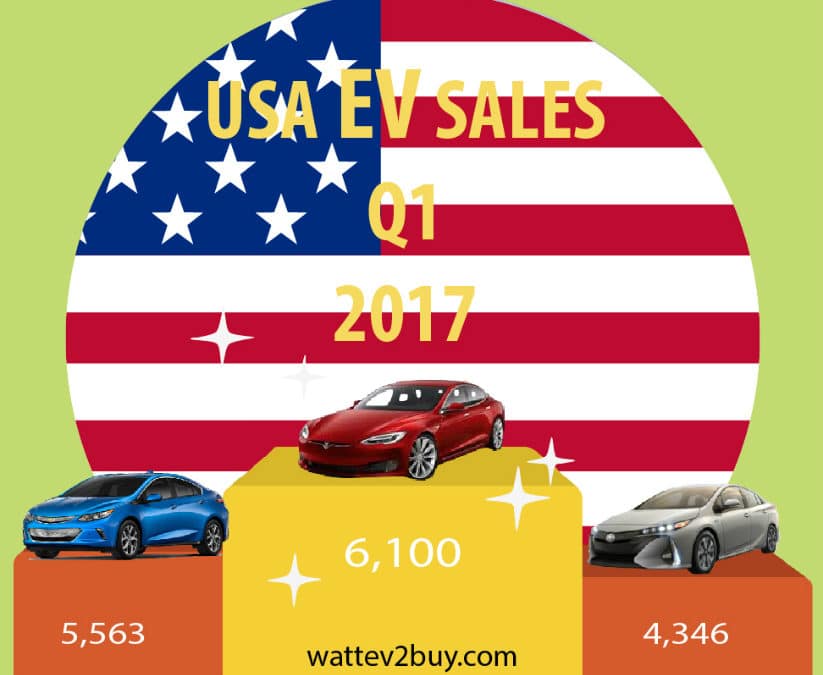
We look at the Top brands, Best and Worst Models and how the battle between battery electric (BEV) and plug-in hybrid (PHEV) technologies play out in the summary of USA EV Sales Q1 2017.
The highlights for USA electric car sales in Q1 2017 was:
There are no surprises in the Top 3 Electric Vehicle Brands as Tesla remained on top, due to increase sales of the Tesla Model X, and GM and Toyota brought new models to book. Quarter 1 2017 was the first full quarter for the Chevrolet Bolt, the world’s first mass-market car. The Chevrolet Bolt‘s performance was rather disappointing, with sales dropping from a January high. The reason can be one of two, either GM‘s slow roll-out is to blame, or most buyers are waiting for the Tesla Model 3. Toyota’s only Plug-In Hybrid (PHEV) vehicle, the Toyota Prius Premium, performed remarkably well, taking in consideration that the battery capacity and range does not offer a real advantage to its competitors.
The bad boy on the block was Ford, barely hanging on to the Top 5 list of electric cars. Were it not for Porsche’s bad performance in the VW Group; the German automaker would have unseated Ford in the Top 5. BMW dropped out of the Top 5 list as Toyota entered the list in the third position. Daimler showed commendable improvement while Hyundai and Volvo joined Ford on the losing side. Nissan still shows consistent growth with its only electric vehicle, the Nissan Leaf.
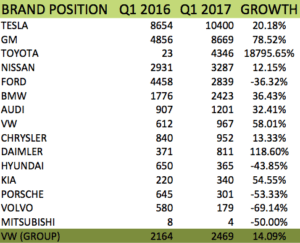
Of the new electric vehicle models that came to market in this quarter, the Toyota Prius Premium, a PHEV outperformed GM‘s Chevrolet Bolt, a BEV by nearly 30%, a disappointing performance for the first mass-market electric vehicle. Both Mercedes-Benz and BMW had two more models in this quarter compared to 2016, with the Mercedes-Benz C350e and Mercedes-Benz GLE 550e outselling the BMW 330e and BMW 740e.
The Mercedes Benz S550 PHEV, BMW i3 2017 and Tesla Model X were the best performing existing models, although for the BMW i3, its the 50% improvement in battery capacity that attributed to its increase in sales.
The Tesla Model S sales remained flat on a year-to-year basis, despite continued improvements in its software and hardware.
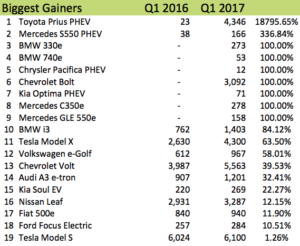
Sales of the Cadillac ELR fizzled out completely in anticipation of the release of the Cadillac CT6 PHEV this month. Both the Porsche Cayenne and Panamera showed big losses in sales from a year ago, impacting on total growth for the VW Group. Judging from the Ford models sales slump, it is clear the century-old automaker needs to reassess it electric vehicle strategy. The big drop in the Volvo XC90 T8 can be attributed to the challenge faced by all automakers coming late to the electric vehicle party. To enter the electric vehicle market, lagging brands alter existing models to include batteries but in the process lose performance as drivers complain about smaller fuel tanks.
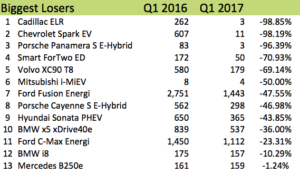
Battery Electric Vehicle’s (BEV), of which nearly half is constituted by the two Tesla models, outperformed plug-in hybrid electric vehicles. Over 20,000 BEV units were sold in the first quarter of 2017 compared to just under 15,000 a year ago. Q1 2017’s 19.2% increase in sales showed a slight improvement for the technology on Q1 2016 when BEV outsold PHEV with 17%. The USA is one of the few countries where BEV vehicles outsold PHEV’s since 2016, read our blog on the Top 10 EV Markets.
In total there is 13 BEV models and 20 PHEV models available in the USA market in 2017 so far. Consumers had a choice of seven new PHEV models in Q1 2017 and one BEV compared to the same period in 2016.
New model’s coming to market in the next quarter include three plug-in hybrids, the Cadillac CT6 PHEV, BMW 530e, and the Porsche Panamera 4 E-H, while only one BEV, the Hyundai IONIQ Electric will be released, should there be no surprises from Tesla on the Model 3.
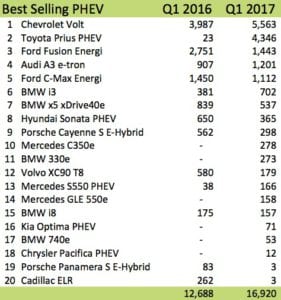
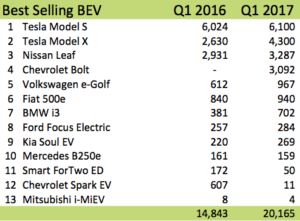
Please leave us a comment on your thoughts regarding the electric vehicle models available to the US consumer.
Note on data used: For comparison purposes, the BMW i3 sales data was assumed to be divided in two, to accommodate for the BMW i3 BEV and REx PHEV
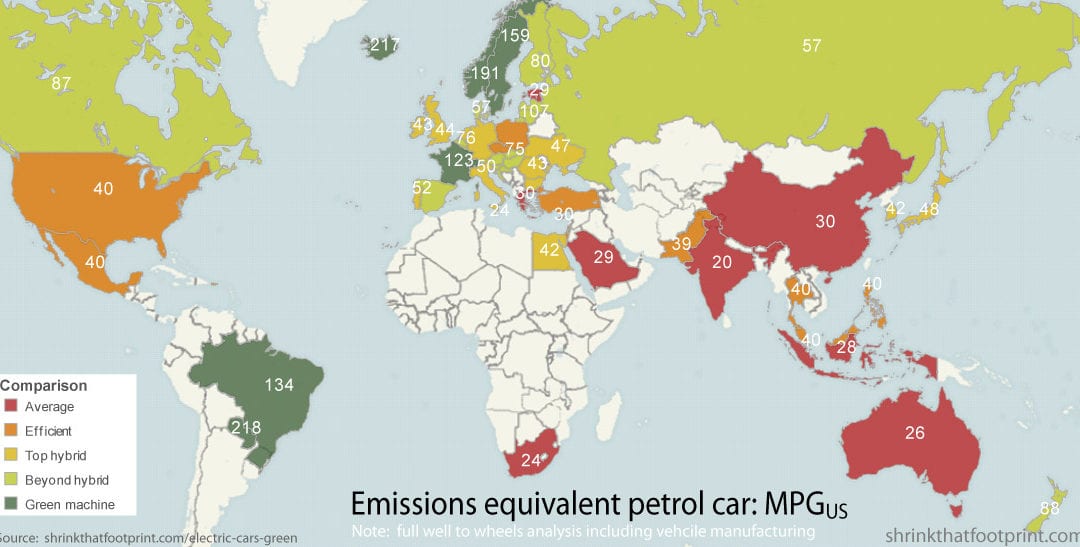
ONE
Bloomberg printed an article this week named “The Electric Car Rush Started Too Early” following BMW‘s release of its financial statements, showing a profit margin of only 8.9%, which was the lowest since 2010. The reason for the pressure on some automakers bottom line is the heavy investment required in research and development for the strategy shift towards new mobility trends, including autonomous vehicles, electric vehicles, connected (focus on secure), and shared mobility options. In BMW‘s case, the investment so far is $4.3 billion. The article also criticized EV’s real environmental cost by the hand of a graph (below) from the website shrinkthatfootprint.com showing that EV’s carbon emissions, when charged from coal, can be as much as four times higher than when charged from green sources such as hydro and other renewables.
TWO
Next EV‘s CEO announced this week that it plans to commercially launch an affordable Level 4 Autonomous electric vehicle in the USA by 2020. The model will be released under the company’s newly minted NIO brand. NIO is partnering with Israeli Mobileeye (camera-based autonomous systems), Nvidia (AI chip) and NXP semiconductors on the autonomous system.
THREE
The Mercedes parent, Daimler AG invested in ChargePoint, the operator of a network of charging stations. The investment is in line with the German automakers push into electric vehicles.
Another significant investment this week was by the Shanghai Listed Far East Smarter Energy Group in the UK based Detroit Electric. The investment totaling £1.5 billion will eventually lead to the creation of 400 jobs at the company’s Leamington Spa facility for the production of its SP:01 EV.
FOUR
Although light on new commercial electric vehicles the Geneva Motor Show this week offered some great eye candy in the form of new concept vehicles, which included:
Nissan announced the unveiling of the new version of its popular Leaf EV expected in September, with commercial sales shortly after that. The Leaf is expected to have a range of 200 miles and some autonomous driving ability through its ProPilot system.
Techrules from China unveiled their four wheels three seater production sportscar, the Techrules REn, which features range extender technology.
FIVE
On the regulatory front. In the east a ministerial meeting was called in India, chaired by the finance ministry to setting standards for the country’s electric vehicle future. In the west, the British Budget failed to give anything new to the electric vehicle sector. Some market observers expected guidance on emissions and carbon taxes. Chancellor Hammond did, however, confirm £270 for EV’s AI and robotics.
.

ONE
The disruption caused by the threat of electric vehicles is finally hitting home, and in no other week has pushback by the proxies of the affected parties been so prominent than the past week. The efforts to block the march of electric vehicles has reached new heights as old foes Big Corn, and Big Oil agreed to work together in defending the transportation fuel sector. Reuters reports the Renewable Fuel Association (AFR) and American Fuel and Petrochemical Manufacturers (AFPM) will target electric vehicle incentives to “level” the playing fields. We hope the AFR and AFPM remember all the subsidies and support they received over the years to “level” the playing fields.
In the USA report by the Sierra Club, a respected environmental association, reported on the drive by various States to penalize electric vehicle owners. The report speculates that the efforts, already successful in ten States and considered in a further six, is backed by the Oil Industry. Only four States have been successful in blocking the attack. Penalties in the form of fees varying between $50 and $300 per year are levied on drivers. In a separate effort, the Alliance of Automobile Manufacturers asked the newly Trump appointed Environmental Protection Agency Tsar, Scott Pruitt, to withdraw the Obama era agreed on 54.5MPG emissions benchmark required by 2025. The AAM’s reasoning is that achieving the standard is too costly and that the consumer’s demand is not there to support such a stringent rule. Really? Our question to the AAM is how can the consumer demand something if the supply of something else is stuffed down their throats?
In Hong Kong, a mainstay market for Tesla, the Financial Secretary in his budget announced that the 20-year-old tax incentive for first time EV registrations would be scrapped, and the tax discount on electric vehicles be capped at around $12,500. The result is that the cost of a Tesla Model S could nearly double in price. The move is in a bid to limit overall car ownership.
TWO
Following on the news three weeks ago that Scotland Yard would acquire electric vehicles for operational purposes the Swedish Police announced the testing of electric vehicles to phase out all fossil fuel use by 2030. Ten cars are tested in three cities in the country. The test would be to utilize the cars as administrative vehicles.
THREE
Porsche will unveil a powerful Panamera E-Hybrid; Various auto manufacturers this week teased their hybrid and electric vehicle lineup for the Geneva Auto Show to be held from the 9th to 19th of March 2017. The vehicles include:
FIVE
SEAT, the Volkswagen-owned auto manufacturer will display an electric vehicle prototype at this week’s Mobile World Congress in Barcelona, Spain. The vehicle includes it’s Digital Access technology, replacing a key with a mobile phone. The first pilot will kick-off at its factory in Spain, using employees. Connectivity and the Internet of the Vehicle are bringing the world of mobile ever closer to the auto sector.

ONE
The respected Economist Magazine this week commented on forecast adjustments by various investment houses for the penetration of electric vehicles. Up till last year, the consensus was that only 4% of new vehicles would be electric by 2025. BNP Paribas now forecast 11% penetration by 2025, while Morgan Stanley see’s a 7% penetration. In 2016 international EV sales increased with nearly 750,000 units (42%) in spite of a low fuel price environment. One factor driving the change of heart are aggressive regulations to support environmental targets. In Norway electric vehicles now makes up 37% of new vehicle fleet amid government support while in China the Government aims to have EV’s make up 8% of new vehicles by 2018. Technology has also moved much faster than anticipated and battery cost, a long time stumbling block is coming down faster than anticipated, with some mega factories coming online within the next two years. Our hearts go out to the automakers that failed to notice the trend, RIP Fiat, Toyota, Honda, Hyundai, and the list goes on, not to mention Big Oil.
TWO
This week Tesla CEO Elon Musk commented on the disruption of self-driving cars to the sector during the World Government Summit in Dubai. Mr. Musk was in Dubai for the launch of Tesla in the Emirates. His comments indicated that Tesla would have its first Level 4 Autonomous system available by the end of 2017. The disruption is significant to the auto sector since once a self-driving car is available, it will devalue new cars without the technology. According to Mr. Musk, the disruption will be slow initially but that in ten years from now all new cars will have the capability to be autonomous. It’s significant that Mr. Musk made the comments at a Government Summit as regulations, not technology seems to be the biggest hurdle at the moment. Will technology force the pace of Governments? We sincerely hope so.
FOUR
The Wall Street Journal reported on the Chinese Electric Vehicle market hitting a road block, with new electric vehicles sales down over 60% for January. China up till now has been the mainstay of the sector with sales increases in 2015 of 300% and 50% on top of that in 2016. The recent clampdown on corruption in the sector which led to a range of new regulations being forced on the Chinese market since December 30, 2016, is seen to be the reason for the sharp slowdown. The Wall Street Journal reported on fines of $150 million imposed on some companies in September 2016. The fines were as a result of subsidy fraud. The Chinese Government also indicated earlier the year that they want to increase barriers to entry and limit the market to around ten manufacturers, down from over 200 currently, in a bid to improve quality and safety of the end product.
FIVE
The 3rd event in the current series of the Formula-E electric vehicle street racing calendar held Buenos Aires Argentina ended yet again with a victorious Renault.eDams team. The e.Dams driver, Swiss-born Sebastian Buemi clinched his 3rd win of the series. The Brasilian Lucas Di Grassi’s 2nd position kept Audi’s ABT Schaeffler standings in the overall second position. The Chinese teams of Next EV and Techeeta were the only teams climbing the rankings, now lying 4th and 5th respectively. Newcomer Panasonic Jaguar has yet to score a single point in the 3rd season, with its drivers Evans and Carrol ending 18th and 19th.